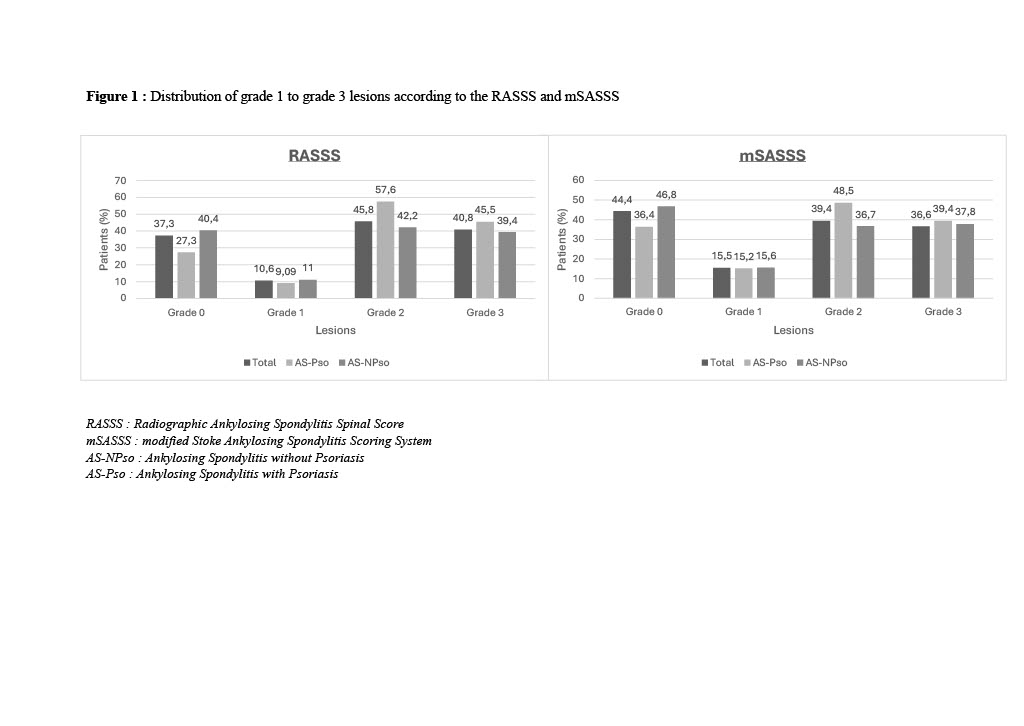Session Information
Date: Sunday, November 17, 2024
Title: SpA Including PsA – Diagnosis, Manifestations, & Outcomes Poster II
Session Type: Poster Session B
Session Time: 10:30AM-12:30PM
Background/Purpose: Patients with ankylosing spondylitis and psoriasis (AS-Pso) were classically older, smokers, overweighted, with lower prevalence of the HLA-B27 status and an equal sex ratio compared to patients without psoriasis. Concerning structural damages on radiographs, few data are currently available. The aim of this study is to compare radiographic spinal structural involvement in ankylosing spondylitis (AS) according to the presence of psoriasis (AS-Pso) or not (AS-NPso).
Methods: This monocentric retrospective study was conducted on 142 AS-patients followed between 2008 and 2021. All patients presented radiographic sacroiliitis according to modified New York criteria. Spine X-Rays, demographical and clinical data were evaluated at the same time. Radiographic structural assessment was established by one experienced reader blinded to psoriasis status on sagittal X-Rays according to the RASSS (from 0 to 84) and the mSASSS (from 0 to 72) with excellent intra reader reliability > 0.8).
Results: 142 patients were included and 33 had psoriasis lesions (23.2%). The median age was 54 years [47-62] and most of them were male (70.4%), smokers (66.6%), with positive HLA-B27 (77.6%). The median disease duration was 14 years [6-26] and 23.9% received csDMARD. Patients’ characteristics at inclusion were similar between both groups, except smokers more frequent in AS-NPso and csDMARDS more consumed in AS-Pso. Finally, 89 patients (62.7%) presented structural damage with the RASSS and 79 patients (55.6%) with the mSASSS. The mean RASSS was 13.1 (± 20.0) and 11.5 (± 16.5) (p=0.54) for AS-NPso and AS-Pso patients respectively. The mean mSASSS was 10.6 (± 16.2) and 9.9 ( ± 14.8) (p=0.6) for AS-NPso and AS-Pso. Analysis of the subscores for the RASSS and the mSASSS did not differ between groups. At the disco-vertebral unit (DVu), analysis did not reveal any preferential location for structural lesion in both groups. For the RASSS, linear regression analysis showed associations with age (value 0.23; p=0.01), disease duration (value 0.28; p < 0.002), male gender (value 0.20; p=0.01) and CRP >5 mg/L (value 0.18; p=0.03). For the mSASSS, linear regression analysis showed associations with age (value 0.22; p=0.01), disease duration (value 0.25; p < 0.003), male gender (value 0.22; p=0.004). For AS-Pso male gender was the only variable associated with the RASSS (value 0.48; p=0.009) and mSASSS (value 0.39; p=0.02).
Conclusion: In AS patients, presence of psoriasis did not modify radiographic spine structural lesions based on the RASSS and the mSASSS and their subscores. Male gender is the main factor of structural involvement in AS-Pso. Most of the variables known to be associated with spinal structural damage in the literature were also found in this population (CRP, male gender, age, disease duration).
To cite this abstract in AMA style:
Favre-Felix I, MENNINI A, Morizot C, LAFFAIRE M, Chary-Valckenaere I, Loeuille D. Radiographic Structural Spine Assessment in Ankylosing Spondylitis According to the Presence or Absence of Psoriasis [abstract]. Arthritis Rheumatol. 2024; 76 (suppl 9). https://acrabstracts.org/abstract/radiographic-structural-spine-assessment-in-ankylosing-spondylitis-according-to-the-presence-or-absence-of-psoriasis/. Accessed .« Back to ACR Convergence 2024
ACR Meeting Abstracts - https://acrabstracts.org/abstract/radiographic-structural-spine-assessment-in-ankylosing-spondylitis-according-to-the-presence-or-absence-of-psoriasis/


